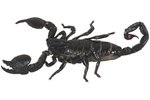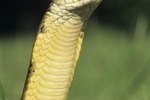
The chain of islands that make up Indonesia are extremely biodiverse, with new plant and animal species being discovered there with regularity. With such an immense variety of wildlife, it’s no surprise that Indonesia is home to some dangerous life forms. Probably the most dangerous animals in Indonesia are snakes; however, a few insects, and one notable lizard, stand out as possibly giving snakes a run for their money in the danger department.
Mass-Murdering Mosquitos
The mosquito might not be the first bug that comes to mind when thinking about dangerous insects, but these disease-carrying parasites are one of the planet’s most prolific killers, responsible for over 1 million deaths worldwide each year. Potentially fatal mosquito-borne illnesses in Indonesia include dengue fever, chikungunya, Japanese encephalitis and malaria. The Centers for Disease Control warns travelers to Indonesia to get vaccinated and take preventive prescription medications for the latter two illnesses prior to traveling, and to take all precautions against mosquito bites while staying in Indonesia.
Toxic Tomcat Beetles
In 2012, the rove beetle, known locally as the “tomcat beetle,” made headlines throughout Indonesia as infestations of this tiny poisonous bug wreaked havoc on the human population. Less than a centimeter in length, this thin, red and orange beetle is sometimes mistaken for an ant. Although they can be a beneficial insect, feeding on insects that do damage to crops, these beetles carry a toxin that contains an irritant called “pederin.” This toxin, which is more potent than cobra venom, is automatically released when the beetle comes into contact with human skin, causing painful boils and itching.
The King of Nightmares
In 2011, a new species of venomous larrine wasp was discovered on the Indonesian island of Sulawesi. Known locally as “the king of wasps,” researchers gave it the official name “Megalara garuda,” named after Garuda, a half-human, half-bird creature from the Hindu religion. Typically, adult larrine wasps grow no longer than an inch, but the adult males of M. garuda reach up to 2 1/2 inches in length. As if that wasn’t horrifying enough, the males also have large, spiked mandibles that are as long as their forelegs. So far, the only specimens found have been deceased, so not much else is known about them. Until live specimens can be located and studied, what those mandibles are used for can only be left to speculation -- and nightmares.
The Infectious Komodo Dragon
In Indonesia, dragons are alive and well. The world’s largest living lizard, the Komodo dragon is also one of the most dangerous. This beast has been known to reach lengths of over 10 feet and typically weighs over 150 pounds. The bite of the Komodo dragon has long been known to be deadly. For a long time scientists believed that this was due to infection from the large amounts of bacteria carried in the lizard’s saliva, but in 2009 researchers discovered that the Komodo actually produces an anti-coagulant venom that causes its prey to go into shock.
References
- American Mosquito Control Association: Mosquito-Borne Diseases
- Department of Health, Victoria, Australia: Mosquito-borne disease in returned travellers - alert for health professionals - 26 February 2013
- Living in Indonesia: Medical Advice for Travelers to Indonesia: Disease Concerns and Health Precautions
- Centers for Disease Control and Prevention: Health Information for Travelers to Indonesia
- AntaraNews.com: Poisonous Insects Still Spreading Horror In Java
- Bali Discovery Tours: Tomcat on the Prowl
- National Geographic Daily News: Bizarre "King of Wasps" Found in Indonesia
- ZooKeys: Megalara Garuda, a New Genus and Species of Larrine Wasps from Indonesia (Larrinae, Crabronidae, Hymenoptera)
- Smithsonian National Zoological Park: Reptiles & Amphibians: Komodo Dragon
Photo Credits
-
Jupiterimages/Photos.com/Getty Images
Writer Bio
Jean Marie Bauhaus has been writing about a wide range of topics since 2000. Her articles have appeared on a number of popular websites, and she is also the author of two urban fantasy novels. She has a Bachelor of Science in social science from Rogers State University.




